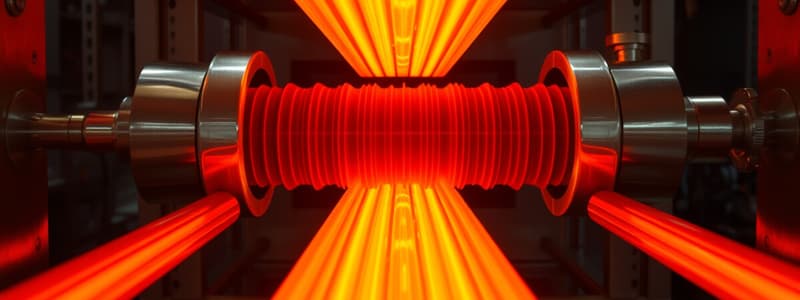Podcast
Questions and Answers
What is the primary focus of heat transfer as a scientific subject?
What is the primary focus of heat transfer as a scientific subject?
- The determination of heat transfer rates and their effects. (correct)
- The measurement of temperature variations only.
- The cooling of electronic devices exclusively.
- The design of heating systems only.
Which of the following systems does NOT directly rely on heat transfer analysis?
Which of the following systems does NOT directly rely on heat transfer analysis?
- Television sets.
- Digital clocks. (correct)
- Heat exchangers.
- Vehicles designed for high-speed travel.
How does conduction transfer heat?
How does conduction transfer heat?
- By direct contact between molecules of different temperatures. (correct)
- Through electromagnetic waves.
- By absorbing thermal radiation from other bodies.
- Through the movement of gas particles only.
What is a common outcome of heat transfer processes?
What is a common outcome of heat transfer processes?
In what scenario is ablation specifically utilized?
In what scenario is ablation specifically utilized?
What type of heat transfer involves the movement of fluids?
What type of heat transfer involves the movement of fluids?
Which of the following is NOT a method of heat transfer?
Which of the following is NOT a method of heat transfer?
Why is heat transfer significant in engineering applications?
Why is heat transfer significant in engineering applications?
What is the primary difference between heat and temperature?
What is the primary difference between heat and temperature?
In thermodynamics, what does a thermodynamic analysis provide?
In thermodynamics, what does a thermodynamic analysis provide?
When heat is transferred between two mediums, which principle governs the direction of heat flow?
When heat is transferred between two mediums, which principle governs the direction of heat flow?
Why might the temperature of a small glass of hot water be greater than that of an ocean?
Why might the temperature of a small glass of hot water be greater than that of an ocean?
Which statement best describes the concept of thermal equilibrium?
Which statement best describes the concept of thermal equilibrium?
What does the study of thermodynamics primarily focus on?
What does the study of thermodynamics primarily focus on?
In the context of cooling a beverage, what does the principle of conservation of energy imply?
In the context of cooling a beverage, what does the principle of conservation of energy imply?
What aspect of heat transfer is most crucial in practical applications such as production processes?
What aspect of heat transfer is most crucial in practical applications such as production processes?
Flashcards are hidden until you start studying
Study Notes
Heat and Temperature
- Definitions: Heat is the total energy of molecular motion in a substance, while temperature measures the average molecular energy.
- Dependency: Heat depends on particle speed, number, size, and type. In contrast, temperature does not depend on these factors.
- Example: A small glass of hot water can have a higher temperature than an ocean, but the ocean has more total thermal energy due to its larger number of particles.
Thermodynamics
- Energy Transfer: Heat transfers from higher temperature to lower temperature until thermal equilibrium is achieved.
- Science Focus: Thermodynamics studies the amount of heat transfer between equilibrium states, without specifying the time required for this process.
- Conservation of Energy: Thermodynamics informs how much heat needs to be transferred but lacks guidance on timing, affecting practical applications like cooling beer.
Heat Transfer
- Importance: Heat transfer determines heating and cooling rates, crucial for practical applications in various technologies and industries.
- Applications: Key in designing computers, televisions, household appliances, and ensuring safety in vehicles by preventing overheating.
- Phase Changes: Heat transfer can produce phase changes, such as melting and boiling, which are utilized in engineering scenarios, including thermal shields in spacecraft.
Methods of Heat Transfer
- Conduction: Heat transfer occurs through direct contact; energy is exchanged but not matter.
- Mechanism: Molecules at higher temperatures vibrate more, transferring energy to neighboring cooler molecules.
Practical Applications of Heat Transfer Science
- Home Design: Heat transfer studies inform decisions on thermal insulation and heating systems in construction.
- Industrial Equipment: Equipment like heat exchangers, condensers, and refrigerators are designed based on heat transfer principles.
- Advanced Engineering: Sophisticated technology such as cars or planes integrates heat transfer studies for maintaining optimal operating temperatures.
Studying That Suits You
Use AI to generate personalized quizzes and flashcards to suit your learning preferences.




